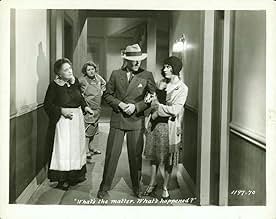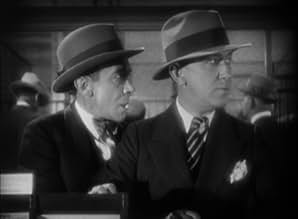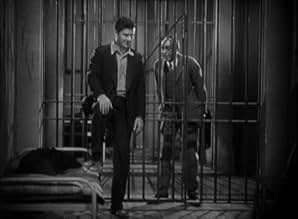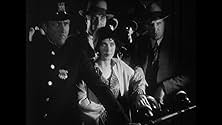Adicionar um enredo no seu idiomaA criminal known as Thunderbolt is imprisoned and facing execution. Into the next cell is placed Bob Moran, an innocent man who has been framed and who is in love with Thunderbolt's girl. Th... Ler tudoA criminal known as Thunderbolt is imprisoned and facing execution. Into the next cell is placed Bob Moran, an innocent man who has been framed and who is in love with Thunderbolt's girl. Thunderbolt hopes to stave off the execution long enough to kill young Moran for romancing h... Ler tudoA criminal known as Thunderbolt is imprisoned and facing execution. Into the next cell is placed Bob Moran, an innocent man who has been framed and who is in love with Thunderbolt's girl. Thunderbolt hopes to stave off the execution long enough to kill young Moran for romancing his girl.
- Direção
- Roteiristas
- Artistas
- Indicado a 1 Oscar
- 2 vitórias e 1 indicação no total
- Thug in Bank at Robbery
- (não creditado)
- Prisoner #8
- (não creditado)
- Black Cat Cafe Patron
- (não creditado)
- Chuck - 1st Prisoner #5
- (não creditado)
Avaliações em destaque
Mankiewicz's famous telegram to Ben Hecht describes how desperate movie studios were to hire good writers. "Millions are to be grabbed out here and your only competition is idiots. Don't let this get around."
Mankiewicz was the highest-paid writer in Tinseltown. Kael described, "His heroes weren't soft-eyed and bucolic; he brought good-humored toughness to the movies, and energy and astringency. And the public responded, because it was eager for modern American subjects." In "Thunderbolt," adapted from a Charles and Jules Furthman story, Mankiewicz's script focuses on Jim Lang (George Bancroft), nicknamed Thunderbolt, wanted by the police. His girlfriend, 'Ritzy' (Fay Wray), is seeing banker Bob Moran (Richard Arlen) behind Jim's back. Lang is captured and is headed for the chair. In jail, he discovers who Ritzy's boyfriend is and frames Bob in a cop's murder. When arrested and sentenced, Bob finds himself in the jail cell next to Thunderbolt.
"Thunderbolt" was the type of movie designed for director Josef von Sternberg for his first talkie. The silent movie director of 1927's "Underworld," which introduced the gangster genre, was excited to be making talkies. He said he was "no longer at the mercy of movie house organists."
Sternberg especially loved to mix music with his actors' dialogue. In a classic nightclub scene, singer actress Theresa Harris, in her film debut, belts out a song while Thunderbolt and Ritzy are in an argument. Between Harris' numbers, the jazz band plays in the background while tension builds between Lang and nearby loud customers. The tense sequence reveals the inner turmoil of Thunderbolt. Film critic Andrew Sarris notes, "'Thunderbolt' is, in some respects, as much a musical as a melodrama." Sternberg was praised overseas for his film, receiving a telegram from German director Ludwig Berger, stating "I saw your film 'Thunderbolt' and congratulate you with all my heart. It is the first fully realized and artistically accomplished sound film. Bravo!" "Thunderbolt" was the second talkie for actor George Bancroft, his first was the now lost 1929 'The Wolf of Wall Street.' The actor earned a Best Actor Academy Award nomination for his role as Thunderbolt.
The future was bright for Mankiewicz, working alongside his younger brother, Joseph, who wrote the titles in "Thunderbolt." Herman is known by today's movie fans as the first screenwriter for 1939's "The Wizard of Oz," and for his collaboration with Orson Welles in 1941's "Citizen Kane."
Bancroft stars a a tough hood in love with Fay Wray. But she's trying to go straight with Richard Arlen, who works in a bank. A man hunt captures Bancroft and convicts him to death row. But even from the cell, Bancroft is able to frame Arlen for a murder during a ban robbery. Arlen is sentenced to death row and ends up across the hall from Bancroft. Will there be fairness? Will there be redemption? As in Underworld, Bancroft is terrific as the obsessed and all-powerful thug. His voice is great as he growls and groans and threatens. Wray looks stunning, and Arlen is good as the innocent man.
For a 1929 talkie, this film has its stagnant moments when the editors didn't know when to cut. But it also features some terrific work by von Sternberg.
The entrance scene into the jazz club is a barrage of trellises and picket fences... quite beautiful... and also boasts a really nice song from Theresa Harris (who usually played a maid). There's also a wondrous scene where Arlen has been hurt and is being tended by his mother (Eugenie Besserer). While's she's applying iodine, he pulls his hands away and the bottle smashes. Both try to clean it up and the scene ends in a giggling tickle fight. Totally unexpected and totally wonderful.
Fred Kohler plays a convict. Tully Marshall is marvelous is a jittery warden.
The ending is probably expected but is beautifully done.
This Takes Place in the First Half and while the Remainder of this Gangster-Romance is Peppered with a Few Interesting Flourishes,
None Equate the Impressive Opening and Once the Movie Gets to Prison the Film is Absent Sternberg's Signature Touches.
In Face the Movie Grinds to a Halt and is just Uninteresting Banter and Prison's Inanimate Existence.
The Dialog Deliveries are Pause Laden, Rhythmic Readings that are Stiff, Laborious, and so Wearily Dated as to be Painful.
Fay Wray is Hardly a Presence, Richard Arlen is OK, and George Bancroft (Oscar Nominated) is Domineering but Hardly Special.
Overall, a Curiosity and Film Historians Should Give it a Look for Context and the Director's Complete Filmography.
But Casual Movie Fans and Seekers of some "Old-Stuff" are Likely to be Bored to Death and Very Disappointed.
This isn't a gangster film, it's an intelligently written character study and in-depth look into the mind of a mobster. You find writer Jules Furthman's name on virtually every other classic Hollywood picture of the 20s, 30s and 40s. His style was quality and his skill was creating believable engaging stories with real genuine characters. His story was further adapted by H Mankiewicz - who wrote the scripts for the probably the other half of the classics from this period. Needless to say - this is well written with fascinating and deeply faceted characters.
Josef von Sternberg directed this which by the look of it was his fiftieth talkie. Surely it's impossible that this was his first sound film? Being made in 1929, it's still a little experimental, not quite everything works so this is not one of his best pictures. Nevertheless he creates a brooding almost surreal atmosphere with real tension. That style intensifies significantly in the latter part of the film on death row which has an almost dream like feel about it.
The story is tense, the characters are believable, the production is innovative but this is not a perfect film. To enable clear sound recording, some but not all of the actors speak very slowly which sounds especially weird when the actor they're talking with is speaking normally. Actors had their own individual vocal coaches then with different techniques thus the inconsistency and maybe not being a native English speaker, von Sternberg probably didn't notice the subtle differences.
As great a director as he was, von Sternberg was given the impossible task of trying to make Fay Wray seem like a proper actress. Not even he could do that and predictably she's absolutely dreadful. As always she just projects that limp, whining and insipid expression to convey whatever emotion she's trying to express.
Whether she's pretending to be a hard as nails gangster's moll or a reformed, sweet and vulnerable fragile young thing she's that same bland, shallow character. Not only can't she act but in this she doesn't appear to be able to speak English - what on earth is that accent! She's meant to be a girl from the streets so why is she doing history's worst impression of Queen Mary? That two men could be besotted with this dull sour-faced non-entity completely stretches all credibility.
Você sabia?
- CuriosidadesOne of the earliest of over 700 Paramount productions, filmed between 1929 and 1949, which were sold to MCA/Universal in 1958 for television distribution, and have been owned and controlled by MCA ever since. However, because of its extreme age, and primitive sound recording techniques, there is no record of it ever having been locally televised. On cable TV it received what may have been its first and only telecast on Turner Classic Movies in August 2016.
- Versões alternativasMade in both sound and silent versions.
Principais escolhas
- How long is Thunderbolt?Fornecido pela Alexa
Detalhes
- Data de lançamento
- País de origem
- Idioma
- Também conhecido como
- Thunderbolt
- Locações de filme
- Empresa de produção
- Consulte mais créditos da empresa na IMDbPro
- Tempo de duração1 hora 25 minutos
- Cor
Contribua para esta página



































